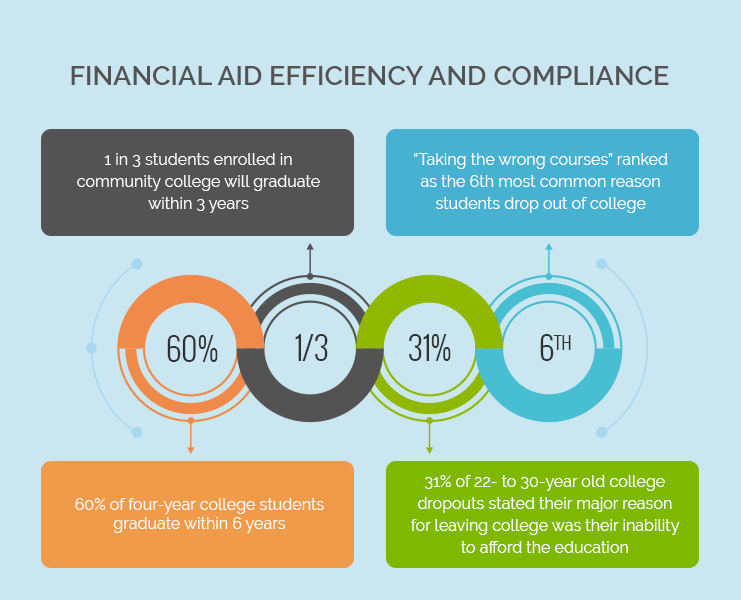The Financial Aid Grind
There’s something students and financial aid staff have in common: they both suffer from process overload. As much as students struggle to complete all of the paperwork and keep track of their course eligibility, financial aid offices are laboring over applications, disbursements, and documents in hopes of remaining compliant with the Department of Education’s requirements. It’s a continuous and exhausting treadmill of to-dos that never seems to ease.
Higher learning institutions do the best they can with the resources they have. Students try their hardest to complete their financial aid applications in time. Then, they wait. With so many applications coming in at once, it takes time to sort through them all, let alone find errors and omissions that require more input from the applicant. It can take months for the financial aid staff to recognize the missing information, track down the student to inform them and walk them through the corrections. Students can spend hours with the call center asking questions and getting help, costing the school thousands of dollars in support. Tragically, many students never get notified, understand why their application was declined or learn of their errors until after the deadline.
All of this drudgery and we haven’t even touched upon the issues with course eligibility. With many higher learning institutions, there are no safeguards to ensure financial aid students do not enroll in classes that fail to contribute to their degree requirements, thus become ineligible for financial aid. Classes are paid for without visibility into whether or not they qualify for financial aid, putting the institution at risk for noncompliance and hefty fees.
Related: New Administration, New Financial Aid Scrutiny
Many students enroll in ineligible classes because they are simply interested in the class and fail to realize the implications of taking an ineligible class. They have no degree roadmap or guided pathway to show them every class option they could take, in the order they should take them, to reach their degree requirements the fastest. Instead, they meander through the educational journey, taking longer than anticipated and racking up debt – both of which are the leading causes for dropout.
- 60% of four-year college students graduate within 6 years
- 1 in 3 students enrolled in community college will graduate within 3 years
- 31% of 22- to 30-year old college dropouts stated their major reason for leaving college was their inability to afford the education
- “Taking the wrong courses” ranked as the 6th most common reason students drop out of college

Because so many of today’s students work and have families, the financial burden of paying for their rising education costs is simply too much. In the balance of work, family and school, something eventually has to give. The harder financial aid is to manage and the more debt that is incurred, the more likely school will be the dispensable option.
Making It Easier for Students and Staff
Simplifying the application and financial aid management process would, of course, do wonders for the both the institution and the students, but how? With federal dollars and the Department of Education in the loop, it isn’t always easy to make improvements. Every application must be completed a certain way before it goes through the standard steps which require so much human interaction. Where there is repetition and standardized processes, there is always room for automation.
Automation via modern software technology is turning the financial aid process on its head. When steps can be automated, the burden of labor is lifted from staff so they can focus on other tasks. The process is faster, more fluid, and infinitely more efficient. Students and parents are empowered with sequential to-do lists, keeping them informed and organized.
Once the financial aid application is received by the institution, it is automatically uploaded into the ERP system and automatically verified for incomplete or erroneous information. The software notifies the institution if the application is complete and the student if there is something missing – within 24-hours of submission. Links to tutorials guide them on how to fix their problems themselves and complete their applications as needed.
When students have real-time access to the status of their application, they can enroll in courses with confidence, choosing only the courses they know will qualify for aid – or at least understand how their choice will impact their budget and graduation goals. Automation and access also give students the ability to map out their coursework semester-by-semester, seeing which course options would get them to their graduation goals the fastest. By taking only the eligible courses in the order they should be taken, students are more likely to stick to their plan and graduate on time and within budget.
Related: How Financial Aid Course Audit (FACA) Is Helping Students Get The Most Out of Financial Aid
Institutions can dramatically reduce their risk exposure through automation. It becomes simple, even basic, for a financial aid office to evaluate whether or not a student should be paid for a class. Ineligible classes can be flagged before students enroll. PeopleSoft, the SIS system of choice for many higher learning institutions, simply isn’t capable of performing a degree audit on every student. It takes another layer of technology to optimize PeopleSoft and automate the process.
The Marriage of Technology and Academics
Higher learning institutions have been relatively slow to break down the silos that often exist between IT and academics. Some schools are traditional and believe the programs, services and processes used in the past are sufficient for today. They are more hesitant to adopt newer technologies. This mindset, however, can be detrimental to the student and the institution.
When technology supports academic initiatives, and today’s students influence those innovations, real transformation occurs. Students are empowered to take control of their own educational journey, equipped with the information they need to stay on track and the technology required to enable them to do so. Institutions streamline processes, reduce labor and expenses, and contribute to the goal of every stakeholder – on-time graduation.
The more students who graduate on time, the more funding schools receive. The fewer dollars institutions must spend on resources to complete manual tasks, the more they can maximize that funding. Automation is the key. Without it, resources and dollars are wasted. With it, however, students and staff can do more with less.
The financial aid process doesn’t have to be so difficult. It can be, and must be, simplified and made more efficient. Students demand and deserve it. Institutions’ viability depends upon it. It requires a symbiotic relationship between academics and technology to make it happen.




